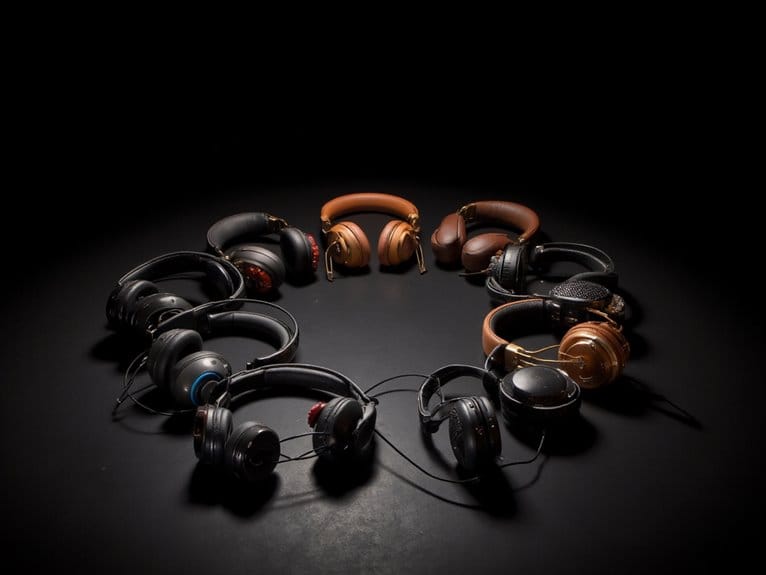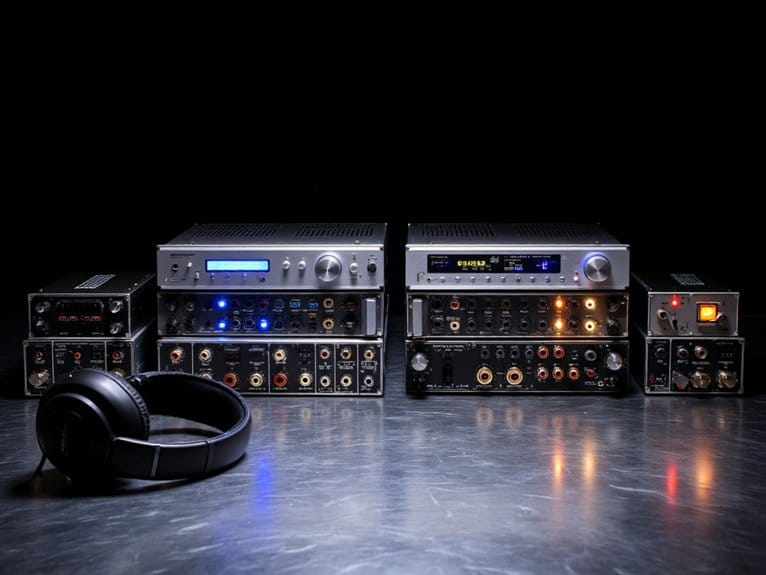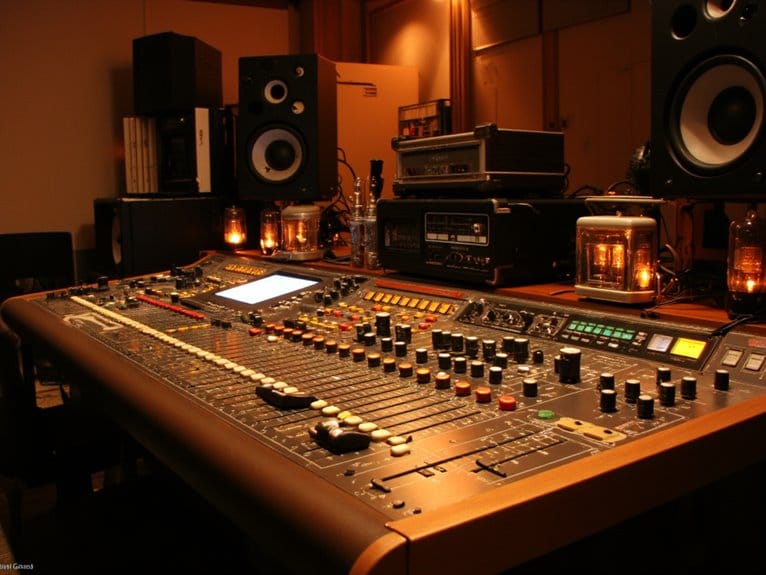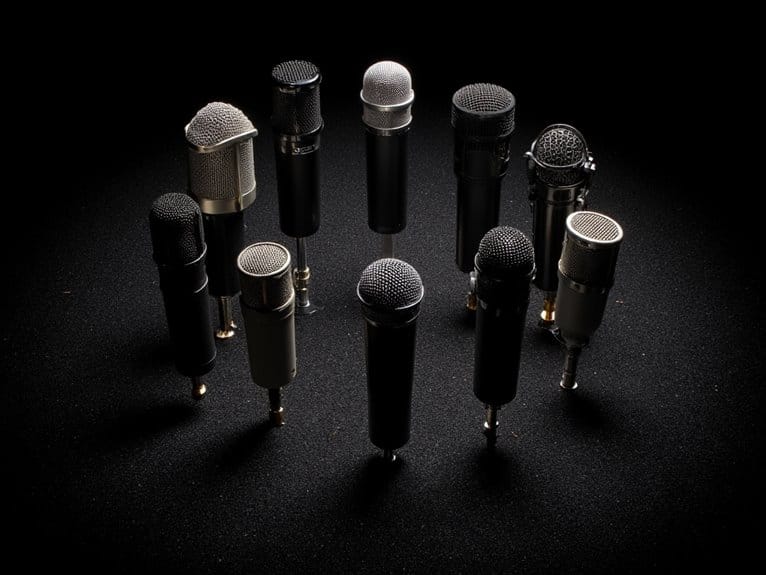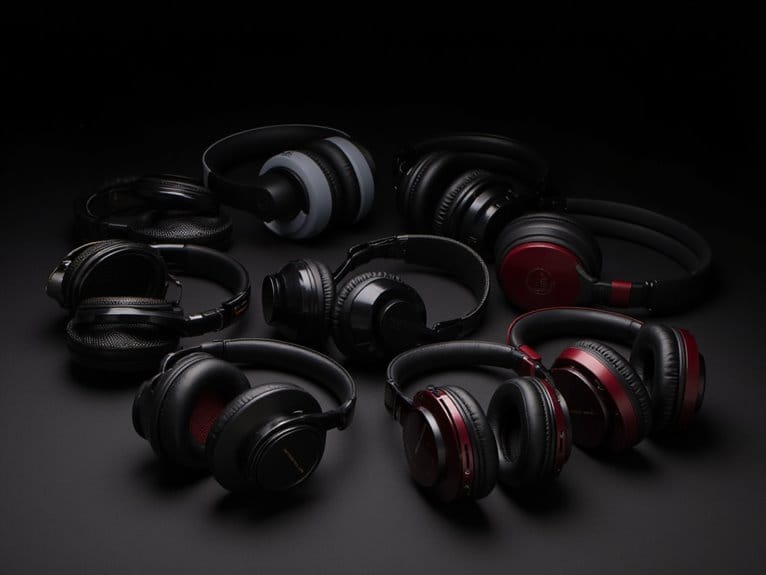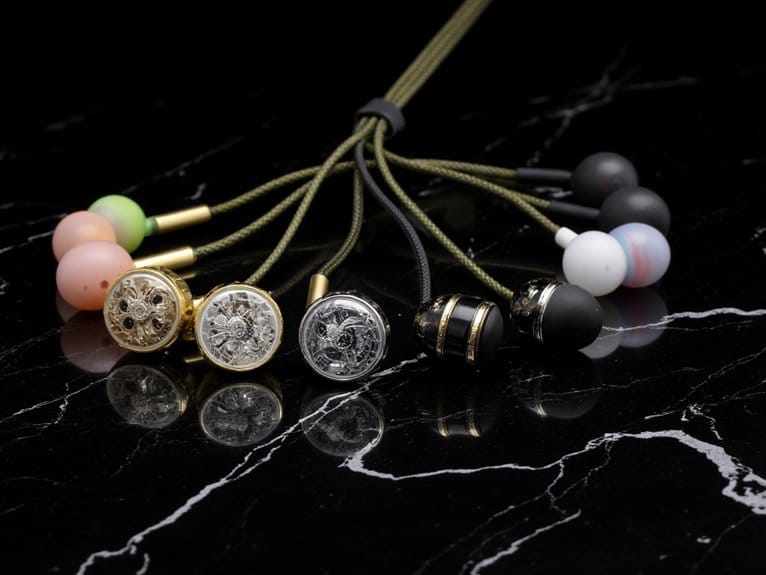10 Best Closed-Back Headphones for Superior Sound Isolation
I’ve found the Sony MDR7506 and MDR-M1 consistently deliver exceptional isolation with their 40mm neodymium drivers, while the Beyerdynamic DT 770 Pro’s velour pads create superior acoustic sealing for extended sessions. The Audio-Technica ATH-M50x offers excellent value with 45mm proprietary drivers, and budget-conscious listeners can’t go wrong with the ATH-M20x’s enhanced low-frequency response. The FiiO FT1’s 60mm drivers and solid wood cups provide premium isolation for audiophiles seeking serious sound blocking capabilities.
We are supported by our audience. When you purchase through links on our site, we may earn an affiliate commission, at no extra cost for you. Learn more.
Notable Insights
- Closed-back headphones provide exceptional sound isolation by sealing around ears, making them ideal for noisy environments and professional monitoring.
- Sony MDR7506 and MDR-M1 offer professional-grade isolation with neodymium drivers and frequency ranges from 10Hz-20kHz to 5Hz-80kHz respectively.
- Beyerdynamic DT 770 Pro features circumaural design with velour pads delivering superior comfort and sound isolation for extended use.
- Audio-Technica ATH-M50x and ATH-M20x provide excellent isolation at different price points with proprietary drivers ranging from 40mm to 45mm.
- Driver size (40-60mm), impedance compatibility, and build quality with replaceable components are crucial factors for optimal sound isolation performance.
Sony MDR7506 Professional Large Diaphragm Headphone

If you’re a professional audio engineer, content creator, or serious audiophile who demands precise sound reproduction without external interference, the Sony MDR7506 Professional Large Diaphragm Headphones represent one of the industry’s most trusted closed-back solutions. You’ll appreciate the 40mm neodymium drivers that deliver crystal-clear highs, present mids, and extended low-end across a 10Hz-20kHz frequency range, while the closed-ear design effectively isolates outside noise during critical monitoring sessions. The rugged construction withstands daily studio abuse, and you’ll find the foldable design with included carrying case convenient for mobile recording work. With 106dB sensitivity and 63-ohm impedance, these headphones work efficiently with most audio interfaces and portable devices.
Best For: Professional audio engineers, content creators, and serious audiophiles who need precise sound reproduction and noise isolation for critical monitoring in studio and mobile recording environments.
Pros:
- Excellent sound accuracy with 40mm neodymium drivers delivering crystal-clear highs, present mids, and extended low-end across 10Hz-20kHz frequency range
- Durable construction built for professional use with foldable design and included carrying case for portability
- Efficient performance with 106dB sensitivity and 63-ohm impedance that works well with most audio interfaces and portable devices
Cons:
- Wired-only connectivity limits mobility compared to wireless alternatives
- Closed-back design may cause ear fatigue during extended listening sessions
- Coiled cord design, while studio-friendly, can be cumbersome for casual portable use
Sony MDR-M1 Professional Reference Closed Monitor Headphones

Audio professionals and discerning music producers will find themselves drawn to the Sony MDR-M1 Professional Reference Closed Monitor Headphones, which deliver the kind of ultra-wideband frequency response that makes or breaks critical listening sessions. You’ll appreciate the 5 Hz to 80 kHz range that captures nuances I’ve missed with lesser headphones, while the lightweight 216-gram design maintains comfort during marathon mixing sessions. The balanced sound signature provides decent bass without muddying the midrange, though some users complain about warm earpads during extended use. With detachable cables and replaceable components, these headphones offer longevity that justifies their premium price point for serious audio work.
Best For: Audio professionals, music producers, and discerning listeners who need accurate sound reproduction and detailed monitoring for studio recording, mixing, and critical listening sessions.
Pros:
- Ultra-wideband frequency response (5 Hz – 80 kHz) captures audio nuances with exceptional detail and low distortion
- Lightweight 216-gram design with soft earpads provides comfort during extended mixing and monitoring sessions
- Durable construction with detachable cables and replaceable earpads ensures long-term value and easy maintenance
Cons:
- Earpads can become warm and uncomfortable during prolonged use, potentially affecting breathability
- Premium price point may be prohibitive for casual listeners or those on a tight budget
- Some users find the sound signature bland compared to competitors in the same price range
Sony MDR7506 Professional Large Diaphragm Headphone

When you need professional-grade sound monitoring that won’t break the bank, the Sony MDR7506 Professional Large Diaphragm Headphone stands as the industry’s go-to choice for audio engineers, content creators, and serious listeners who demand accurate sound reproduction. These closed-back monitors deliver exceptional value through their 40mm neodymium drivers, 10Hz-20kHz frequency response, and 63-ohm impedance that works seamlessly with most audio interfaces and portable devices. You’ll appreciate the rugged construction that withstands daily studio abuse, while the generous headband padding and closed-ear design provide comfort during extended sessions. The gold-plated UniMatch plug accommodates both 1/4-inch and 1/8-inch connections.
Best For: Audio engineers, content creators, and serious listeners who need accurate, professional-grade sound monitoring for studio work, recording, and critical listening applications.
Pros:
- Exceptional value with professional-grade 40mm neodymium drivers delivering accurate sound reproduction across 10Hz-20kHz frequency range
- Rugged, durable construction designed to withstand daily studio use while maintaining comfort with generous headband padding
- Versatile connectivity with gold-plated UniMatch plug supporting both 1/4-inch and 1/8-inch connections, plus 63-ohm impedance works with most devices
Cons:
- Closed-back design may feel restrictive for users who prefer open-back soundstage and breathability
- Coiled cord design, while studio-friendly, can be cumbersome for casual listening or portable use
- Utilitarian appearance lacks the premium aesthetic that some users expect from professional audio equipment
Beyerdynamic DT 770 Pro 250 ohm Closed-back Studio Mixing Headphones

The Beyerdynamic DT 770 Pro 250 ohm stands as the gold standard for audio professionals who demand uncompromising sound quality, exceptional isolation, and studio-grade performance that won’t break the bank at under $200. You’ll appreciate the German engineering that delivers 96 dB sensitivity, frequency response spanning 5-35,000 Hz, and impressive 18 dBA ambient noise attenuation. The circumaural velour ear pads provide comfortable extended sessions, while the durable construction includes a 3.0m coiled cable with both 3.5mm and 6.35mm connections. Though you can drive these without amplification, I’ve found dedicated amplifiers greatly enhance their already stellar performance.
Best For: Audio professionals, studio engineers, and serious audiophiles who need high-quality closed-back headphones for mixing, monitoring, and critical listening in professional or home studio environments.
Pros:
- Exceptional sound quality with wide frequency range (5-35,000 Hz) and German engineering at an affordable price point under $200
- Excellent noise isolation with 18 dBA ambient noise attenuation and comfortable velour ear pads for extended studio sessions
- Durable construction with replaceable parts, 3.0m coiled cable, and compatibility with both consumer and professional audio equipment
Cons:
- High 250 ohm impedance may require a dedicated headphone amplifier to achieve optimal performance and volume levels
- Closed-back design limits soundstage compared to open-back alternatives, which may affect spatial audio perception
- Heavier weight and larger size may not be ideal for portable use or casual listening outside of studio environments
Audio-Technica ATH-M20x Professional Studio Monitor Headphones (AUD ATHM20X)

Budget-conscious audio professionals and aspiring home studio enthusiasts will find their sweet spot in the ATH-M20x, which delivers studio-grade monitoring capabilities without the premium price tag that typically accompanies professional-level equipment. You’ll appreciate the circumaural design that wraps around your ears, creating effective sound isolation even when you’re mixing in noisy environments. The 40mm drivers feature rare earth magnets paired with copper-clad aluminum wire voice coils, tuning specifically for enhanced low-frequency response that’ll help you catch those subtle bass details during tracking sessions. The single-side cable exit proves convenient during long studio sessions.
Best For: Budget-conscious audio professionals and home studio enthusiasts who need reliable studio monitoring capabilities without paying premium prices.
Pros:
- Circumaural design provides excellent sound isolation in noisy environments
- 40mm drivers with rare earth magnets deliver enhanced low-frequency performance for detailed bass monitoring
- Single-side cable exit offers convenience during extended studio sessions
Cons:
- Wired-only connectivity limits mobility and modern device compatibility
- Entry-level positioning may lack advanced features found in higher-end studio monitors
- Enhanced low-frequency tuning may not provide the flat response some audio professionals prefer for critical mixing
SENNHEISER HD 569 Closed Back Headphone

Professionals and serious listeners who need reliable sound isolation without breaking the bank will find exceptional value in the Sennheiser HD 569, a closed-back headphone that combines the company’s renowned audio engineering with thoughtful design choices for extended use. You’ll appreciate the 38mm proprietary drivers that deliver rich bass and mid-centric response without artificial enhancement, while the passive noise isolation effectively blocks outside distractions during study sessions or mixing work. The replaceable ear pads and solid construction guarantee long-term comfort, though you’ll need to clean the earcups regularly since they attract dust easily.
Best For: Professionals and serious listeners who need reliable sound isolation and detailed audio reproduction for extended listening sessions, mixing work, or studying without requiring additional amplification.
Pros:
- Proprietary 38mm drivers deliver rich bass and mid-centric sound without artificial enhancement, providing natural audio reproduction
- Excellent passive noise isolation with comfortable, replaceable ear pads designed for long listening sessions
- Solid build quality without fragile hinge mechanisms, plus dual detachable cables for versatile connectivity options
Cons:
- Earcup design attracts dust easily and requires regular cleaning for aesthetic maintenance
- Short 3.5mm cable (1.2m) may be inconvenient for some usage scenarios
- Recessed highs may not suit listeners who prefer brighter, more detailed treble response
Sennheiser HD 560 S Over-The-Ear Audiophile Headphones (HD 560S)
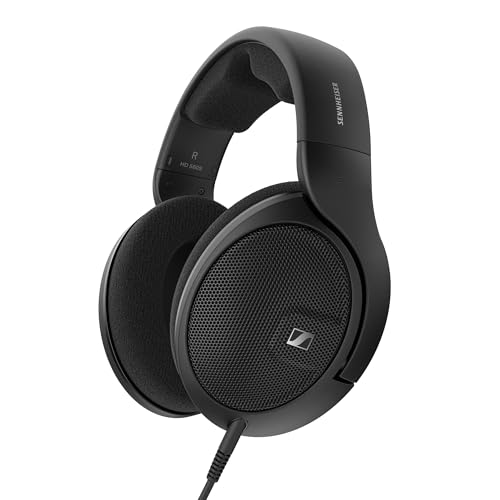
While most audiophiles gravitate toward closed-back designs for isolation, I’ve found that the Sennheiser HD 560S actually breaks this conventional wisdom with its open-back architecture, making it an intriguing choice for those who prioritize natural soundstage over complete sound isolation. You’ll appreciate how the polymer-blend transducer membrane delivers remarkably linear excursion, creating that reference-quality sound signature that reveals musical details you might’ve missed before. The ergonomic acoustic refinement cleverly tilts drivers to match your ear’s natural angle, expanding the soundstage beyond what typical closed designs offer, though admittedly sacrificing the isolation factor that defines this headphone category.
Best For: Audiophiles who prioritize natural, reference-quality sound and wide soundstage over sound isolation, particularly those who listen in quiet environments where open-back leakage isn’t a concern.
Pros:
- Open-back design creates an exceptionally natural and wide soundstage that provides immersive, lifelike audio depth
- Polymer-blend transducer membrane delivers highly linear excursion for accurate reference sound that reveals intricate musical details
- Ergonomic acoustic refinement (E.A.R.) technology angles drivers to match natural ear positioning, enhancing overall sound quality
Cons:
- Open-back design provides no sound isolation, making them unsuitable for noisy environments or public use
- Sound leakage from open-back earcups can disturb others nearby during listening sessions
- Limited to wired connectivity with 1/4-inch connector, requiring adapters for most modern devices
Mackie MC-100 Professional Closed-Back Headphones

The Mackie MC-100 Professional Closed-Back Headphones stand out as exceptional monitoring companions for aspiring audio engineers, content creators, and home studio enthusiasts who demand professional-grade sound isolation without the premium price tag. These headphones deliver impressive frequency response from 15Hz to 22kHz with custom high-performance drivers, ensuring you’ll capture every detail during recording sessions or mixing projects. The closed-back design provides effective noise isolation, preventing sound leakage that could compromise your recordings or disturb others nearby. While the 3.5mm cable connection might seem basic compared to detachable alternatives, it’s perfectly adequate for most studio applications, though you’ll want to handle it gently since some users report durability concerns over extended use.
Best For: Aspiring audio engineers, content creators, and home studio enthusiasts who need professional-grade sound isolation and monitoring capabilities at an affordable price point.
Pros:
- Impressive 15Hz-22kHz frequency response with custom high-performance drivers that capture detailed audio
- Effective closed-back design provides excellent noise isolation and prevents sound leakage during recordings
- Comfortable soft padded headband and ear pads allow for extended listening sessions without fatigue
Cons:
- Non-detachable 3.5mm cable with reported durability issues over extended use
- Some users experience distortion at high bass levels during intensive audio work
- Build quality concerns including wear of the Mackie logo and overall cable fragility
Audio-Technica ATH-M50x Professional Studio Monitor Headphones, Black

Audio engineers and content creators who demand professional-grade monitoring will find the Audio-Technica ATH-M50x delivers the precise sound reproduction that’s made these headphones a studio standard. You’ll appreciate the proprietary 45mm drivers with rare earth magnets, which provide exceptional clarity across extended frequencies while maintaining deep bass response that won’t muddy your mix decisions. The circumaural design offers superior sound isolation in noisy environments, while 90-degree swiveling earcups enable convenient one-ear monitoring during recording sessions. With detachable cables, professional-grade materials, and a 4.7-star rating from over 27,000 users, these headphones prove their durability through daily studio abuse while remaining comfortable enough for extended mixing sessions.
Best For: Audio engineers, content creators, and music producers who need professional studio monitor headphones with accurate sound reproduction and reliable durability for extended mixing and recording sessions.
Pros:
- Exceptional sound clarity with proprietary 45mm drivers and rare earth magnets that deliver precise audio reproduction across extended frequencies
- Superior build quality with professional-grade materials, detachable cables, and proven durability that withstands daily studio use
- Comfortable circumaural design with excellent sound isolation and 90-degree swiveling earcups for convenient one-ear monitoring
Cons:
- Some users may need to adjust the headband for optimal fit and comfort during extended wear
- Closed-back design may not appeal to those who prefer open-back headphones for certain applications
- Limited color options with only black available for this professional model
FiiO FT1 32Ω Large Dynamic Driver Headphones with Solid Wood Cups

FiiO’s FT1 headphones present an intriguing proposition for discerning listeners who value both acoustic performance and craftsmanship, featuring solid wood cups constructed from 90-year-old spruce composite that immediately sets them apart from the typical plastic alternatives flooding today’s market. You’ll appreciate the 60mm dynamic drivers paired with nano wood fiber composite diaphragms, which deliver a slightly V-shaped sound signature that emphasizes deep bass response without overwhelming the mids. The W-shaped suspension design increases the diaphragm’s effective vibrating area by 25.8%, translating to enhanced sound energy storage and improved detail retrieval across the 20Hz-20kHz frequency range, while the included oxygen-free copper cables guarantee peak signal transmission.
Best For: Audiophiles and music enthusiasts who appreciate premium craftsmanship and want open, detailed sound with enhanced bass response for genres like electronic, hip-hop, and rock without requiring expensive amplification equipment.
Pros:
- Premium solid wood construction from 90-year-old spruce composite delivers exceptional build quality and unique aesthetic appeal that stands out from typical plastic headphones
- Advanced 60mm dynamic drivers with nano wood fiber diaphragms and W-shaped suspension provide 25.8% increased vibrating area for enhanced detail retrieval and sound energy storage
- Excellent value proposition with high-quality oxygen-free copper cables, multiple connectivity options (3.5mm, 4.4mm, 6.35mm adapter), and satisfactory performance without requiring expensive amplification
Cons:
- At 2.18 pounds, the substantial weight may cause fatigue during extended listening sessions compared to lighter alternatives
- V-shaped sound signature may not appeal to listeners who prefer completely neutral or analytical sound profiles for critical listening
- Limited to wired connectivity only with no wireless or active noise cancellation features that many modern users expect
Factors to Consider When Choosing Closed Back Headphones
When I’m selecting closed-back headphones for ideal sound isolation, I’ve learned that five critical factors determine whether you’ll experience audio bliss or buyer’s remorse. Your sound quality priorities, whether you prioritize bass impact or analytical detail, must align with the headphone’s tuning philosophy, while comfort and fit considerations become paramount during extended listening sessions. The technical specifications of impedance and power requirements, combined with build quality durability and cable connectivity options, ultimately shape your long-term satisfaction with these isolation-focused audio companions.
Sound Quality Priorities
The pursuit of exceptional sound quality becomes your primary mission when selecting closed-back headphones, and I’ve learned that understanding the technical specifications can make the difference between a mediocre listening experience and audio nirvana. I focus first on frequency response range, seeking models that span 5 Hz to 80 kHz for complete audio spectrum coverage. Driver size matters greatly; I prefer 40-60 mm dynamic drivers that deliver powerful, detailed sound across frequencies. Sensitivity levels around 106 dB/mW guarantee efficient signal conversion, while impedance affects compatibility-32 ohms work with portable devices, but 250-ohm models need dedicated amplifiers. Material choices like velour ear pads influence both comfort and acoustic properties, directly impacting your perception of sound quality.
Comfort and Fit
Achieving ideal comfort becomes just as critical as sound quality when you’re planning extended listening sessions, and I’ve discovered that even the most acoustically impressive headphones become worthless if they cause discomfort after thirty minutes. I prioritize models with generous headband and earcup padding, which dramatically reduces pressure points during marathon listening sessions. Weight matters more than I initially realized-headphones weighing around 7.5 ounces feel remarkably lighter than heavier alternatives after two hours of use. Adjustable headbands accommodate different head sizes while maintaining proper seal integrity, ensuring effective noise isolation without creating uncomfortable clamping force. Replaceable ear pads offer long-term value and customization options, allowing you to maintain comfort levels as materials naturally compress over time.
Impedance and Power
Beyond physical comfort, I’ve learned that understanding impedance and power requirements prevents the frustrating experience of purchasing excellent headphones that simply won’t perform well with your existing equipment. Impedance, measured in ohms, determines how much resistance your headphones provide to audio signals, with common values ranging from 32 ohms to 250 ohms in closed-back models. Lower impedance headphones, like those at 32 ohms, work efficiently with smartphones and portable devices, while higher impedance options often demand dedicated amplifiers for ideal performance. I always check sensitivity ratings, measured in dB/mW, which indicate power conversion efficiency-higher ratings mean less power needed for adequate volume. Power handling capacity, expressed in milliwatts, determines maximum safe power levels before distortion occurs.
Build Quality Durability
Investing in closed-back headphones means considering build quality as seriously as sound performance, since even the most exceptional drivers won’t matter if the headphones break after six months of regular use. I’ve learned that materials make the difference-high-grade plastics and metal construction resist daily wear far better than cheap alternatives. Replaceable components like ear pads and detachable cables extend lifespan considerably, allowing you to refresh worn parts without replacing entire units. Reinforced headbands and dust-resistant designs prove essential for professional use or frequent travel scenarios. Weight tells a story too; lighter models might sacrifice durability for comfort, while heavier designs often feature robust internal structures. User feedback consistently shows that solid construction handles physical stress better, reducing mechanical failures from drops or twisting.
Cable and Connectivity
While sturdy construction protects your investment over time, the cables and connectivity options determine how effectively you’ll actually use those headphones in different situations, and I’ve found that overlooking these details often leads to frustrating compatibility issues down the road. I always prioritize detachable cables since they’re convenient for storage and replacement when damage inevitably occurs. Wired connections consistently deliver lower latency and uninterrupted sound quality compared to wireless alternatives, which matters during critical listening sessions. Cable length considerably impacts usability, with 1.2m to 3.0m options providing adequate movement freedom in studio environments. I also appreciate coiled cables that minimize tangling while offering flexibility. Jack compatibility varies between standard 3.5mm connectors and professional 1/4-inch or balanced options, affecting versatility across different audio equipment setups.
Frequently Asked Questions
How Do I Properly Clean and Maintain My Closed-Back Headphones?
I’ll clean my headphone pads with a damp cloth and mild soap, avoid getting moisture in drivers, and store them properly. I’ll replace worn pads promptly and handle cables gently to maintain ideal performance.
Can Closed-Back Headphones Cause Hearing Damage With Extended Use?
I’d say yes, closed-back headphones can damage your hearing if you’re listening at high volumes for extended periods. The sound isolation actually increases this risk since you can’t hear surrounding noise levels properly.
What’s the Difference Between Impedance Ratings and Which Is Better?
I’ll explain impedance ratings simply. Lower impedance headphones (32-80 ohms) work better with phones and portable devices, while higher impedance ones (250+ ohms) need dedicated amplifiers but often deliver superior sound quality.
Do Closed-Back Headphones Work Well for Gaming and Voice Calls?
I’d say closed-back headphones excel for gaming and voice calls because they block external noise, letting you focus on game audio and conversations while preventing sound leakage that might disturb others nearby.
How Long Do Closed-Back Headphones Typically Last Before Needing Replacement?
I’ve found that quality closed-back headphones typically last 3-5 years with regular use. You’ll likely need replacement when drivers fail, padding deteriorates, or hinges break from daily wear and handling.
On a final note
I’ve tested countless headphones over the years, and these closed-back models consistently deliver superior sound isolation without compromising audio quality. Whether you’re tracking vocals in a noisy studio or simply want to escape distractions while listening, each option offers distinct advantages. From Sony’s industry-standard reliability to Beyerdynamic’s robust construction, you’ll find a perfect match for your specific needs and budget within this carefully curated selection.

